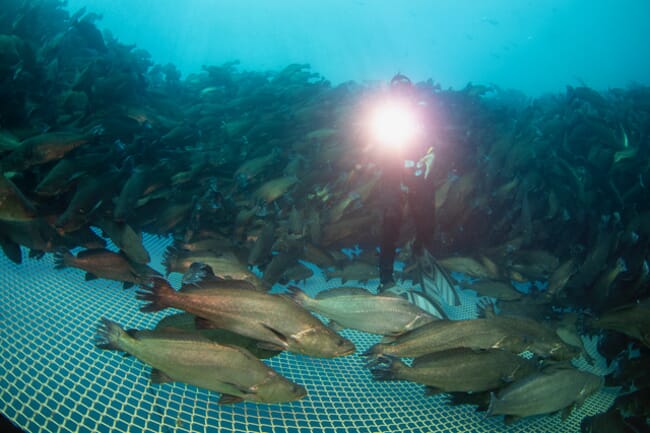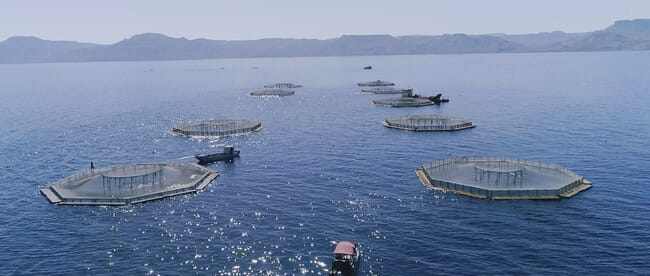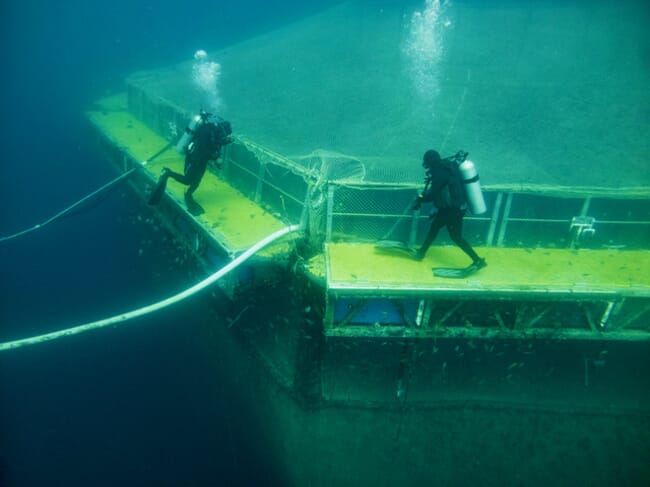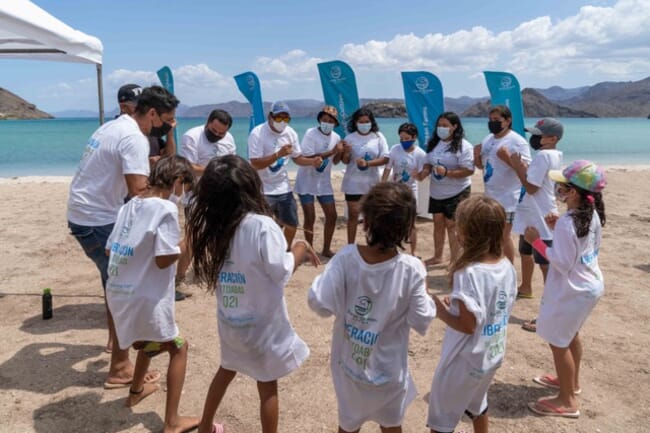
© Earth Ocean Farms
As discussed in a previous article, Totoaba (Totoaba macdonaldi) – a species unique to the Gulf of California – has huge potential in aquaculture. The biological characteristics of the totoaba are extremely well suited for farming, especially with regards to its growth rate, feed conversion ratio (FCR) and adaptability to crowding due to its natural schooling behaviour. These once-scarce fish are now cultivated by several companies in Mexico, both as a means of restoring decimated wild stocks and as a way of forging a new aquaculture industry.
A number of trailblazing public and private efforts to farm this species off the Baja California peninsula have helped to spearhead a young but sophisticated sector, which is all set to scale up. However, the ongoing ban on exports means that the sector is currently limited to domestic sales – effectively stifling the growth plans of the key players. As a result, the Mexican industry is waiting intently for a review of the status of the species by the Convention on International Trade in Endangered Species (CITES), which is due to take place in early 2022. Many of the farmers fervently hope that the export ban will be lifted – if not, the future of the sector will hang in the balance.

© Earth Ocean Farms
Background
The total annual aquaculture production of 500 tonnes is currently restricted to be sold nationally, even though this fish would be an attractive product for the export market. The limited quantity of the high quality white meat enjoys a favourable positioning on the high end market in Mexico’s most important cities. Earth Ocean Farms (EOF), which is currently producing the majority of the tonnage, would like to see the product maintain this status in the national market and have therefore no incentive to scale the production just yet. However, as the pioneers of commercial Totoaba farming, they argue that allowing international trade of the species is vital for establishing a thriving Totoaba industry.
Since 1977, Totoaba has been internationally recognised as an endangered species listed under Appendix I of CITES. The listing was done in response to collapsing stocks, caused by overfishing and habitat degradation. However, despite the trade ban, the large swim bladders – also known as buche or fish maw – of the Totoaba, have continued to be subject to illegal trading, with ineffective governance and the illegal status of the product fuelling high prices on the black market.
Undisputedly, the Mexican authorities did a poor job enforcing the fishing ban and, tragically, the illegal gillnets used by the poachers have resulted in the death of many threatened vaquita porpoises. Vaquita is the most critically endangered marine mammal in the world. For decades now, NGOs and other parties have advocated for better law enforcement to prevent poaching, but the Upper Gulf of California has turned into a battleground without clear solutions in sight.
An academic fightback
Yet, in the meantime, academic and commercial aquaculture activities have countered the threat of extinction of the Totoaba in the wild, through constructive stock enhancement programmes. The hatchery technology for Totoaba is well developed and there are currently three geographically diverse hatcheries (UABC in Ensenada, CREMES in Bahia Kino, and EOF in La Paz) producing juveniles for both restocking and commercial aquaculture activities. Meanwhile researchers have suggested that the status of Totoaba as a threatened species should be evaluated, as indirect evidence showed positive signs of their recovery in the wild (Quiñonez et al. 2015).
In 2022 the Standing Committee of CITES will be meeting to discuss and reconsider the status of the Totoaba – a decision that could be decisive to its future. In some cases, CITES can grant a captive breed exemption, which would legalise the commercial trade of products from a registered breeding facility under Appendix II. On this basis, EOF and other commercial Totoaba farms could apply for export permits with the trade authorities of the countries they aspire to sell to. Just like sturgeon farms are able to legally sell their caviar.
Some environmental NGOs, like the Natural Resources Defense Council (NRDC), oppose the move, claiming that a legalised export channel for farm-raised Totoaba would present an eased export channel for the illegal buche, inevitably giving incentives to poaching in the Upper Gulf. However, there are several points to debunk this presumption.

© Earth Ocean Farms
“The big misunderstanding is to treat buche
and Totoaba (meat) as the same thing,” says Pablo Konietzko, CEO of EOF. In other words, there are two products that are easily distinguishable with distinct market destinations and therefore not the same export channel.
According to Konietzko, “Our (EOF’s) main objective is to produce healthy source of protein to the growing population. We are not focused on the market for the buche. It might come later down the road and if there is a market and a price for that and it makes economic sense to also sell the small buche, of course we are going to do it.”
In any case, the way to differentiate a farmed buche from an illegal one, is the size, since the black market is after the large ones. These would require much longer grow-out periods than the current 18-24 months for the meat, which EOF doubts would be economically feasible.
“Currently everything is based up on black market prices which are absurd,” adds Konietzko, certain that the legal supply should bring down the price of the illegal buche also, which in turn should reduce the incentive for poaching Totoaba in the Upper Gulf.
Moreover, today’s full traceability possibilities could precisely determine the origin of every product. Not only through the advanced genetic markers that all of the hatcheries work with, but through analysing the fatty acid composition, which is connected to the distinct diet of the farm-raised Totoaba. Testing tools for both methods are nothing new, but they need to be more widely available to the relevant authorities.
Totoaba has evolved into an emerging aquaculture species, while the regulations around its trade have not had the chance to catch up with the farming objective of this fish, but rather address the trade of illegally caught fish. This undermines the opportunity to utilise the full potential of this natural resource in a sustainable manner, as some research suggests, “for species threatened with extinction, mariculture may offer both ecological and economic paths to a solution” (Clavelle et al, 2019).
In contrast to conservation farming of terrestrial species, the efficiency of which has been much debated, conservation-linked aquaculture shows promise, as high volumes of endangered aquatic species can be produced at a relatively low cost. Research by Gentry et al (2019) and others suggests that flooding the market with legal farm-raised products would bring down the price enough to reduce the incentive of poaching the endangered species. In the case of the Totoaba, with two distinct products, this might not directly apply, where raising the fish for both meat and buche may only be an alternative future scenario.

© Earth Ocean Farms
However, a more immediate effect of conservation aquaculture for Totoaba would be the stock enhancement programmes such as those run by EOF, CREMES and UABS. These programmes function by producing juveniles under the guidelines for responsible fisheries enhancement.
“We are not getting funded by any government, but we do have all the backup and support of this activity, just as other research institutions have been restocking for the past years,” comments Konietzko about EOF’s annual restocking activities in the Upper Gulf area.
“So we do some education courses for the kids of those communities and when the day comes, they are the ones that do the restocking themselves, so that is very emotional… and it is very satisfying to see that we are not only releasing fish, but we are also planting a seed in the new generations to come”.
In this way, aquaculture operations are an essential part of the preservation of the Totoaba and will have to be matched with effective enforcement of regulations, as well as protection and restoration of habitats.
The past decades of forceless fishery management have demonstrated clearly that the current efforts can not address the problematic situation of the Totoaba alone. It is obvious that, with a growing human population, the demand for endangered species like Totoaba is only increasing. By responsibly utilising advanced captive breeding technologies, conservation-linked aquaculture of Totoaba can not only help secure the preservation of this species in the wild, but also has the potential to bring back a sustainable resource and generate prosperity in an economically depressed region of Mexico.




